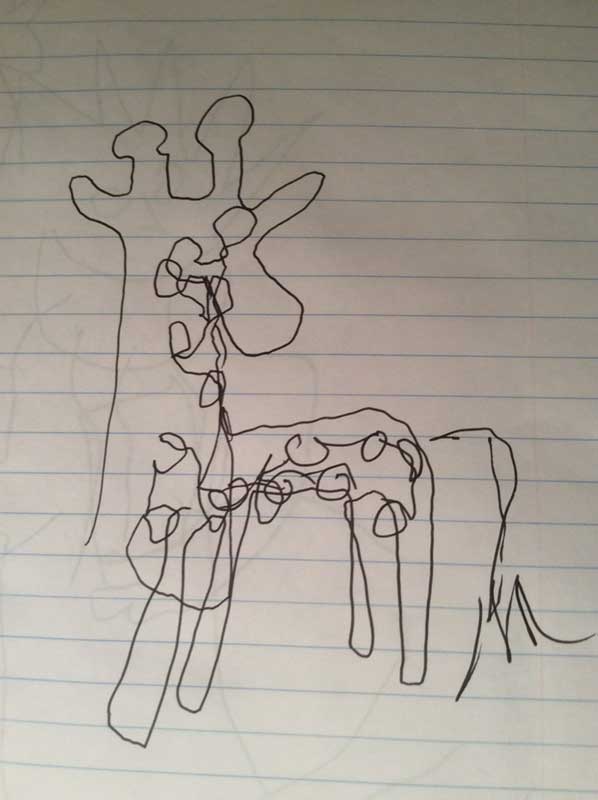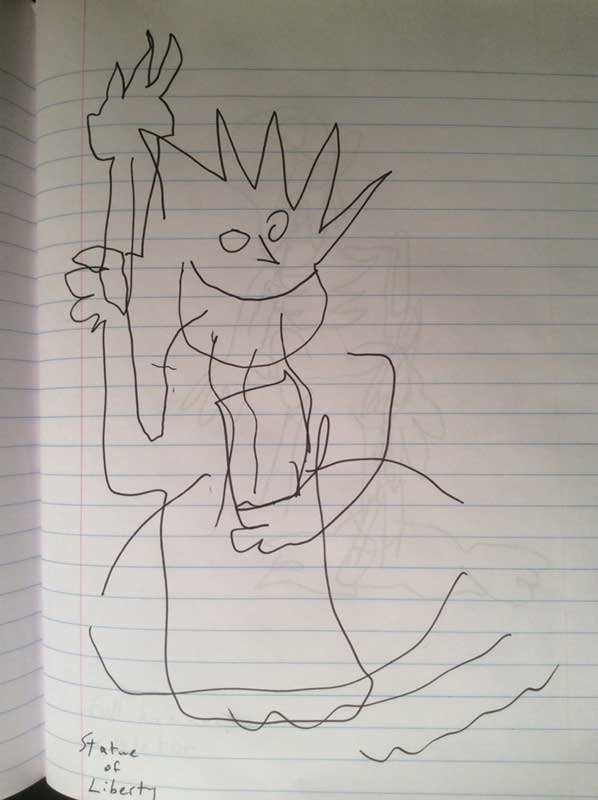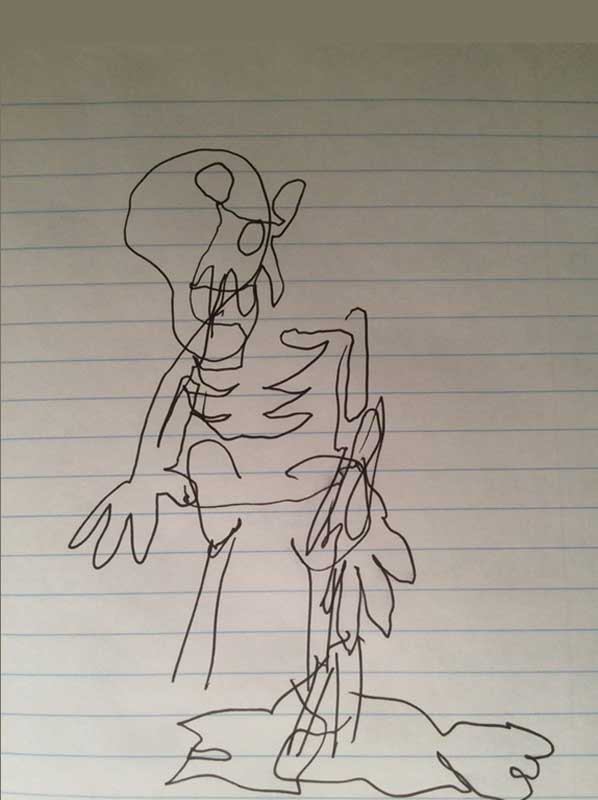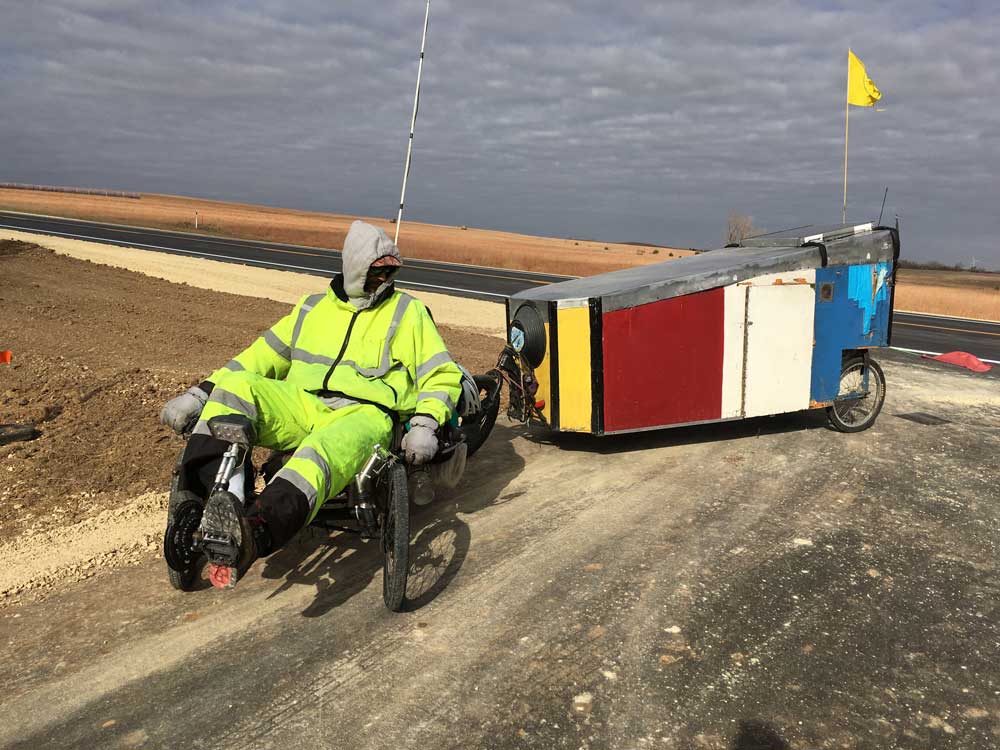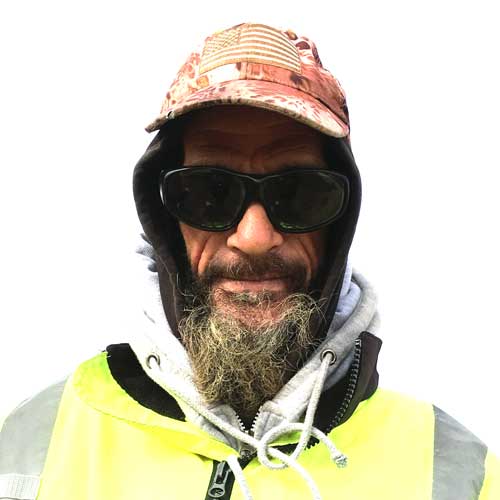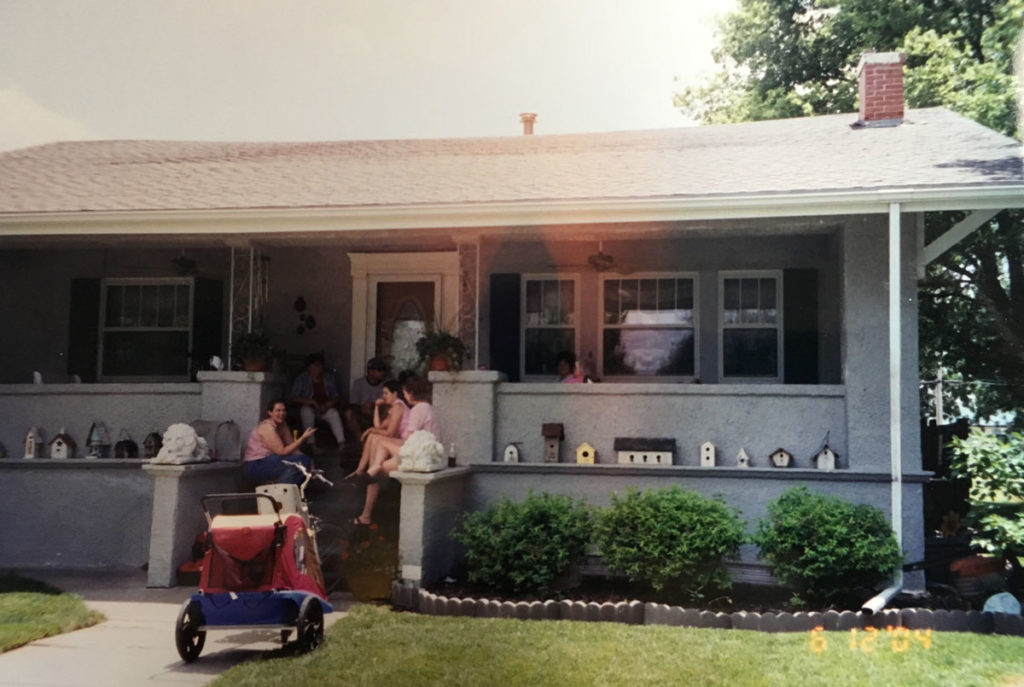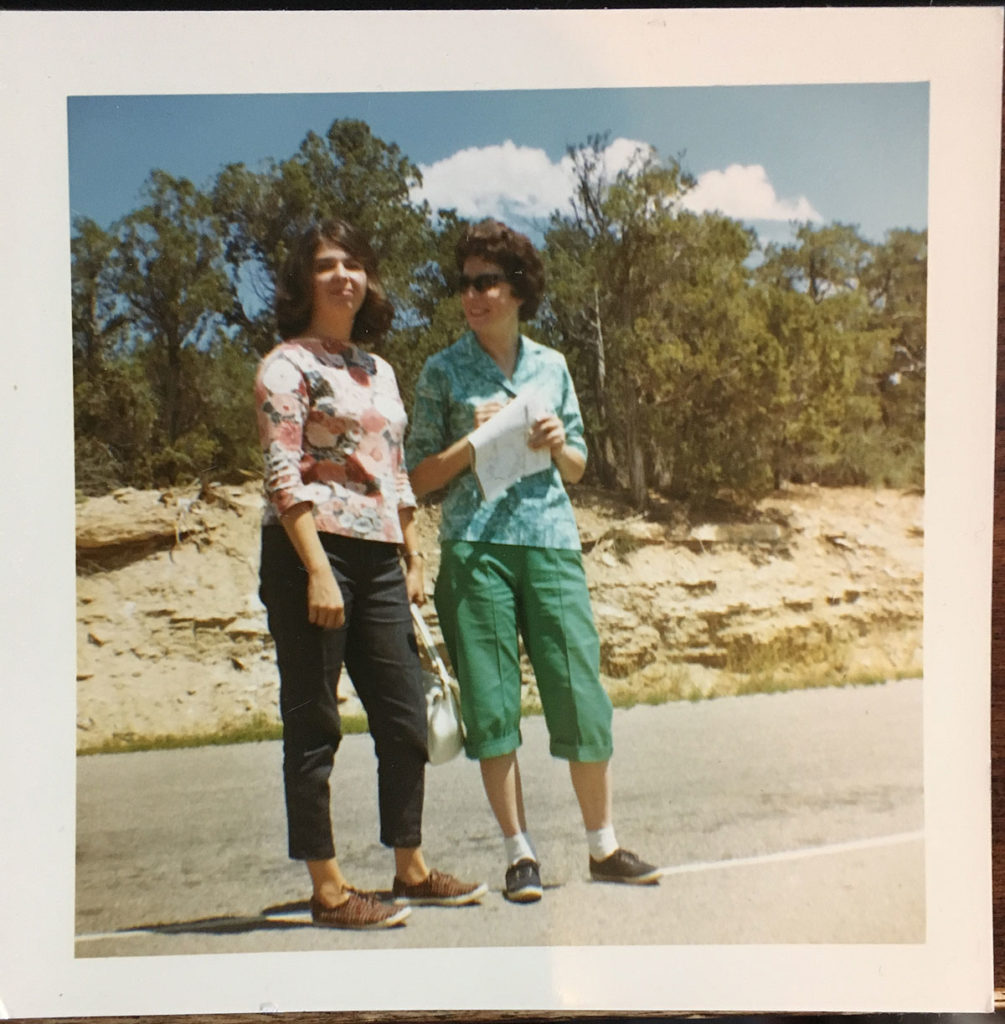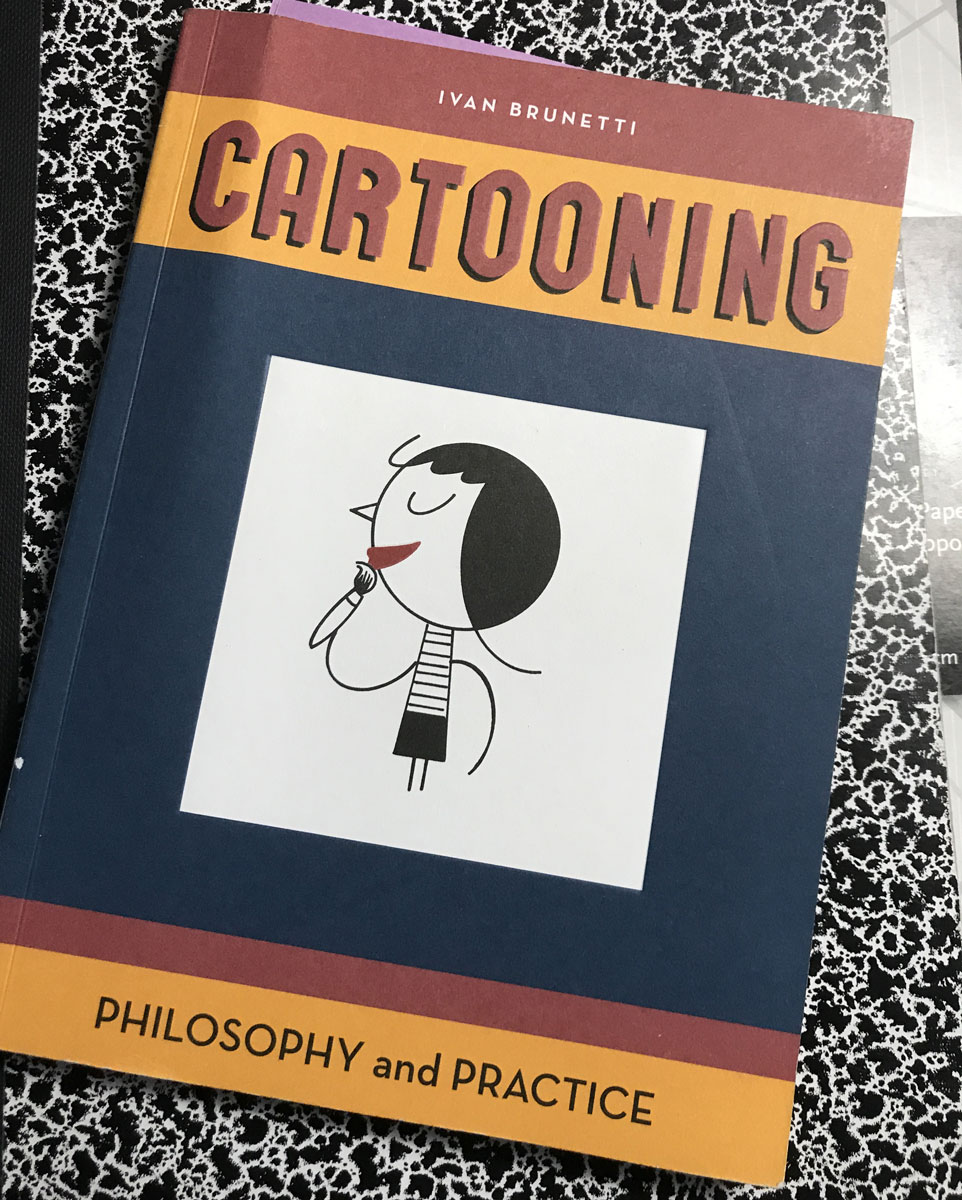Category Archives: Assignments
Writing the Unthinkable Part II – Blind Contour Drawings
These were the first drawings we made in the Writing the Unthinkable Workshop with Lynda Barry on November 23, 2019 in Evansville, Wisconsin. We started by drawing a full breakfast table setting with bacon eggs, and a cup of coffee… with our eyes closed. I forget the time we had to do these drawings, around one or two minutes, I think. I first heard about doing blind contour drawings from Betty Edwards’ Drawing on the Right Side of the Brain book.
The next thing to draw is a giraffe.
Followed by a mermaid.
The Statue of Liberty.
A skeleton.
Drawing blind is a great way to free up the mind. We were drawing in $1.00 composition books, the kind with the marbled black covers, which Lynda explained is useful for drawing because they are so inexpensive you don’t worry at all about messing up something expensive and nice. If you mess up, you can keep going. The thing about drawing with your eyes closed is that there is absolutely no wrong way to do it. You just use your mind’s eye and go for it!
Tony Adams – Adventure Cyclist
Here is a mini-documentary I made along with the students in my digital literacy class. Everyone was to make a video 2-4 minutes long about someone who is interesting that you don’t know well. (Here is the official DS106 video assignment.) I found Tony pedaling his recumbent bike along my morning commute, so I stopped to see if he would visit with me. This is the result.
I wrote about some of the challenges of making video this in an earlier blog. Needless to say, the shorter the video, the harder you have to work at making it something worth watching. I probably spent over ten hours making this thing, but I like how it turned out.
Cross Country Traveler Tony Adams
Thursday evening near sundown while driving home from work, I noticed the strangest thing. I saw a man a little ways off of the road climbing into what looked like a plywood box on wheels. The box looked like it was a bike trailer attached to some sort of bicycle. Like I said—strange. The next morning I was going to work I saw the man again, but this time he was on the road with his human-powered contraption.
I stopped to visit for a few minutes with the man and asked him where he was going. He said he was heading to Colorado. As I drove off and headed towards work, I thought to myself that I should do the same assignment as my Digital Literacy students are working in their online course – the mini-documentary and that I should interview the cycling man for my project.
Immediately I thought about all of the reasons this idea made no sense. It would be awkward, even scary asking the stranger for an interview. I had some other things I wanted to be doing at work, so it would be an inconvenience. I didn’t have a video camera. I all had on me was a dated iPhone and old iPad Mini, both of which had their storage filled to the brim. I would have to delete some stuff to make room to record. It was freezing cold outside and a stiff wind was blowing.
So I stopped at a nearby convenience store, picked up a few energy bars and water, and drove back to where I thought I would find the man. After driving a few miles, I caught back up to him and asked if he could spare a few minutes to talk to me. He agreed, so we found a spot where we could pull off of the road and maybe get out of the fierce wind for a bit.
I learned his name was Tony Adams and he was returning to Colorado after riding out to Virginia and back. He told me he’s been doing these trips for the past 19 years and that he sleeps every night in his 600+ lb homemade house trailer. It is tiny but has several amenities like a propane cook stove, a DVD player and television, a cell phone and a solar panel for charging his devices. He purchased the recumbent bike he was riding and modified it for pulling the heavy trailer that he built by hand from scratch.
Many of the items he uses he finds along the road as he travels, including the three flags that he flies, various electrical chargers and devices. One thing he always keeps an eye out is for old cellular phones that contain SD cards. One card he found had over 30 movies stored on it, providing him hours of entertainment.
Tony was very inspiring to meet, and it makes me want to try to be a little more like him. Just do your own thing and don’t worry too much about what others think about it.
Some of the challenges:
- It was so frustrating to get the video off of my iPhone. It took me forever, and I don’t think it should be this hard.
- It is scary talking to a stranger. I really had to psych myself up to even do it.
- I planned to do several other things on Friday morning. It was inconvenient to change my plans. I had many excuses in my mind not to go back to talk with him.
- Didn’t have my best camera for recording, only an iPhone and old iPad Mini, both of which were completely full. I had to delete apps & podcasts to free up storage for this project on the fly. This was rough because as I’m trying to work the recording quits so I’m trying to delete more stuff so I can record some more.
- After listening to the recording, I have more questions I wished I had thought of, but it was freezing cold. Probably around 30 degrees.
- My batteries drained quickly in the cold. And I kept running out of space and had to delete more apps and content.
- I hoped to get the video edited over the weekend, but that didn’t happen. It is going to be a challenge to get the thing edited during the week to my satisfaction.
Benefits of doing this:
- It was very fulfilling talking with Tony. He’s an inspiration. He only moving 2-3 miles per hour but he’s traveled to Virginia and back.
- In theory, I should be doing the assignments I give to students right along with them, but in practice, it isn’t feasible to always do it. I feel like doing the same challenging assignment, I am reminding myself of exactly what it is that I’m asking my students to do.
I’m still working on the video editing part of the assignment, but the hardest part, meeting a stranger and getting the recordings is done.
Photography and the Visual Image
Photography and the Visual Image
This week we will be looking at visual storytelling through images and photography. How does one make a good photograph? This year I have amassed a huge collection of family photographs. Literally hundreds of photo prints made by different members of my family over the years.
We really like picture-taking in our family but if I am brutally honest, most are mediocre, unremarkable snapshots. (My mom was a big fan of double-prints too, so often there’s twice the amount of prints too.)
What is the difference between a snapshot and a composed photograph?
Snapshots are made by people with no formal training and lack having a natural eye for composition. In the snapshot above, there are some things I like and some things I don’t care for at all. I can see a front view of the first home I purchased (we no longer live there). On the porch is a gathering of my siblings, and I see a stroller/bike trailer on the sidewalk.
I can see my wife’s birdhouse collection and my family, but no details on either. In a composed photograph, the photographer identifies the key subject and emphasizes it. The photographer composes the frame and decides what to include and exclude. That is the job of the photographer — to tell the viewer what is important to see and what is not. (By the way, this fact is foundational to being media literate. All media are constructed. Media creators include and exclude things based on their tastes, preferences and biases. To be media literate, we must realize this fact when we view the work of others.)
What is the main subject of the above picture? It is hard to tell, isn’t it? Is it the house? Is it the decorations and landscaping of the house? Is it the family on the porch of the house? The bicycle and bike trailer? There is a lot going on here and the photographer decides to try to include everything; that is wrong! Well not wrong if you are making snapshots, but wrong if you want to make memorable photographs. I would much prefer to see faces up close, or certain interesting features of the house, or even the bike and trailer. I have literally hundreds of snapshot pictures and maybe one out of ten or twenty strikes me as really interesting to look at.
This next picture (below) is also from my vast collection of family photos. Although technically, this too is a snapshot made on what was undoubtedly a less complex camera than the previous photo (a Brownie camera perhaps?), it seems the photographer who made this one was more conscious of design elements that make a good photograph, or at least they lucked into using them.
The very first thing that strikes me in this photograph is the use of the Rule of Thirds. Notice how the subject, the two women, are not placed exactly in the center but are instead more towards the left. This automatically makes a more interesting photo to look at. Placing a subject dead center is static, and boring.
The photo is likely from the 1960s and I love the still-vibrant colors in this outdoor scene. Many photos of this age have faded, particularly the blues and greens and many photos like this have the reddish hue of age. Not this one! It has probably been kept in a relatively cool and dry environment out of the sunlight.
The mother/daughter duo appear to be wearing clothing of a similar style, although not matching. The similar cut of their tops (look at the angled waist hem) makes me wonder if they bought these clothes while out shopping together. I like that it is close enough to see their faces, yet far enough back to include their entire bodies. It is obvious that the people are what the photographer wants us to see. The background is simple. Rocks, trees and sky, and they are standing in the middle of the road which tells me this is an off the beaten path sort of place without throngs of traffic.
This is such a fun photograph, I attempted to make a small watercolor painting of it. I will probably try the same scene again to see if I can improve my technique any.
To recap, to make a quality photograph you need to select a definite subject. Make it obvious. Don’t make the viewer have to guess what you are trying to show us. Then to increase interest, put the subject not in the center, but off to the side using the Rule of Thirds. Finally, consider the colors and lighting of the scene. In my second example photo, the lighting is strong and bright, which caused the human subjects to squint and to wear sunglasses. It also creates harsh shadows, which are often undesirable. If you make photographs on overcast days, or in the shade, or during the dawn and dusk hours when the sun is low in the skies you can get really interesting results with your natural ambient light. If you do these things, the quality of your picture taking will likely move from simple snapshots into the realm of true photograph.
Cartooning Homework 2.1
 Page 34 of the Brunetti book on Cartooning calls for three single panel cartoons paying attention to action within an identifiable place, line quality , composition and areas of solid black. This is the first of my three.
Page 34 of the Brunetti book on Cartooning calls for three single panel cartoons paying attention to action within an identifiable place, line quality , composition and areas of solid black. This is the first of my three.
So far as an identifiable place goes, it may be that only people who do summer league sports recognize this location – a ball park. I saw this harried mom pulling two little girls in a collapsible wagon that is common to families who travel to various ball parks across the country.
I didn’t really make any areas of solid black, opting for hatched areas of gray instead of solid black. Didn’t really think about using solid black.
Cartooning by Brunetti
I purchased Brunetti’s Cartooning book for Kindle some time ago. I started doing the exercises but didn’t stick with it for very long. You know, work, life, and things. I recently ordered a hard copy of the book hoping that seeing it lying around in my work area would be more of a reminder to me than a bunch of bits buried somewhere deep in my Kindle would be. Below are some of the first week’s efforts.
Draw cartoon characters from memory:
Draw 100 sequential five second sketches of whatever pops into mind representing a stream of consciousness:
Make a composition of many drawings using a unified theme:
Monday Feb 18 Writing
I wrote two pieces yesterday. One was about the food served aboard ship. I have been conversing with Desert Storm Navy vets about their favorite shipboard meals. Breakfast was a favorite, especially when fresh milk was available. Total length of that effort was 920 words.
I also wrote a piece on the daily routine aboard ship. I was having trouble remembering specific times that certain things occurred so I will have to do more research on that. But I covered things like morning quarters, sweepers, working hours at sea vs in port. Total length of that piece was 860 words.
Also watched about an hour of PBS Frontline special on Desert Storm.
Total for day was 1780 words. If I can maintain that pace this will be my best week.
Most Heartwarming Advertisement Ever
A year and a half ago, Gillette Razors released this short video, but it took me a year to discover it in my social media feed. It is probably the most heartwarming “commercial” I have ever seen. It is a perfect example of short-form digital storytelling. I often give an assignment to my students called mini-documentary and going forward I plan to show this to my students as an example of how it is done well.
The pacing, the lighting, the sound, the music and the story all flow effortlessly. It quickly draws the viewer in and you become absorbed in the story. That, my friends, is good storytelling. Please watch first, then come back and read what else I have to say after the video.
Did you watch the video? Read no further until you do. I will wait…
You’re back? It is really good, right? Ok, I have more to say, but that will come in another post. Click here to continue…
Raindrops Keep Falling on my Head
Today’s Daily Create was to make a mashup. I decided to do one of music and an image. Then I decided to record my own music and use my own photograph. My New Year’s resolution was to make more things and write more on my blog, so this post is a daily create activity that sort of got out of hand. Daily Creates are typically done in 10-15 minutes or so, but this one took considerably more than that. But that’s ok. That’s the whole idea of doing daily creative activities. Sometimes it leads to something more substantial.
I used an app on my iPad called Voice Record Pro by Dayana Networks. I love this app. It is the Swiss Army Knife of audio recording apps. I sometimes use it in my Hardware and Networking class to demonstrate the concept of a server. Voice Record Pro is so versatile, it includes a web server feature that turns your iPad into a web server so you can easily download your recordings. There are about a dozen other ways to get your files as well. For example, you can upload directly to YouTube in video form, you can send it to your other Apple devices via AirDrop (my favorite way). If you are a user of Apple devices and don’t use AirDrop you are missing out. It is the simplest of ways to transfer files from one device to another but only works on Apple products.
I recorded the ukelele part, then I recorded myself singing as well and mixed these files together in Adobe Audition. I think when I get more confidence, I’ll play and sing at the same time. Finally, I brought the audio into Adobe Premiere and added some pictures and simple animations to be rendered as a video that I then uploaded to YouTube.
